2024.12.16
- Features
-
Services/ProductsServices/ProductsServices/Products

Learn more about the retail trading conditions, platforms, and products available for trading that FXON offers as a currency broker.
You can't start without it.
Trading Platforms Trading Platforms Trading Platforms
Features and functionality comparison of MetaTrader 4/5, and correspondence table of each function by OS
Two account types to choose
Trading Account Types Trading Account Types Trading Account Types
Introducing FXON's Standard and Elite accounts.
close close

-
SupportSupportSupport

Support information for customers, including how to open an account, how to use the trading tools, and a collection of QAs from the help desk.
Recommended for beginner!
Account Opening Account Opening Account Opening
Detailed explanation of everything from how to open a real account to the deposit process.
MetaTrader4/5 User Guide MetaTrader4/5 User Guide MetaTrader4/5 User Guide
The most detailed explanation of how to install and operate MetaTrader anywhere.
FAQ FAQ FAQ
Do you have a question? All the answers are here.
Coming Soon
Glossary Glossary GlossaryGlossary of terms related to trading and investing in general, including FX, virtual currencies and CFDs.
News News News
Company and License Company and License Company and License
Sitemap Sitemap Sitemap
Contact Us Contact Us Contact Us
General, personal information and privacy inquiries.
close close

- Promotion
- Trader's Market
- Partner
-
close close
Learn more about the retail trading conditions, platforms, and products available for trading that FXON offers as a currency broker.
You can't start without it.
Features and functionality comparison of MetaTrader 4/5, and correspondence table of each function by OS
Two account types to choose
Introducing FXON's Standard and Elite accounts.
Support information for customers, including how to open an account, how to use the trading tools, and a collection of QAs from the help desk.
Recommended for beginner!
Detailed explanation of everything from how to open a real account to the deposit process.
The most detailed explanation of how to install and operate MetaTrader anywhere.
Do you have a question? All the answers are here.
Coming Soon
Glossary of terms related to trading and investing in general, including FX, virtual currencies and CFDs.
General, personal information and privacy inquiries.
Useful information for trading and market information is posted here. You can also view trader-to-trader trading performance portfolios.
Find a trading buddy!
Share trading results among traders. Share operational results and trading methods.
- Legal Documents TOP
- Client Agreement
- Risk Disclosure and Warning Notice
- Order and Execution Policy
- Complaints Procedure Policy
- AML/CFT and KYC Policy
- Privacy Policy
- eKYC Usage Policy
- Cookies Policy
- Website Access and Usage Policy
- Introducer Agreement
- Business Partner Agreement
- VPS Service Terms and Condition

This article was :
published
updated
Weekly FX Market Review and Key Points for the Week Ahead
In the foreign exchange market for the week that ended on December 15th, the USDJPY was boosted by strong economic data from the U.S., speculation that the Bank of Japan (BOJ) would not raise interest rates, and a strengthening dollar in overseas markets. The pair reached the 153 yen level on December 15th.
The EURUSD sagged as the European Central Bank (ECB) decided to cut the interest rates. The GBPUSD also fell on speculation that the Bank of England (BoE) would maintain its current policy.
December 9 (Mon)
Traders took a risk-off stance after China announced monetary easing. The yen weakened against the dollar, with the USDJPY rising to the 151 yen level.
Meanwhile, Japan's GDP for the July-September period was revised upward to an annualized 1.2% (forecast: 0.9%). However, the impact on the market was limited.
December 10 (Tue)
While no major economic data was released, the rise in long-term U.S. interest rates pushed the USDJPY to the 152 yen level. Although the pair briefly pushed back into the upper 150 yen range, dollar buying dominated throughout the day.
December 11 (Wed)
The USDJPY briefly fell to around the 151 yen level after some media outlets reported that the BOJ was likely to make another rate hike. However, subsequent reports indicated that the central bank had no immediate plans to do so, pushing the pair back up to the upper 152 yen level.
Meanwhile, the U.S. Consumer Price Index (CPI) for November matched market expectations, with the core CPI increasing 0.3% month-on-month (forecast: 0.3%) and 2.7% year-on-year (forecast: 2.7%). These figures indicated persistent inflationary pressures, and the dollar continued to strengthen.
December 12 (Thu)
The ECB decided to cut interest rates by 0.25% to 3.15% and removed the reference to restrictiveness from the statement. Furthermore, the staff projections lowered the outlook for inflation and economic growth. As a result, the EURUSD declined.
Meanwhile, the USDJPY briefly fell to the upper 151 yen range as U.S. initial jobless claims increased more than expected. However, the dollar was bought back, and the pair rebounded to the upper 152 yen range.
December 13 (Fri)
The BOJ's quarterly Short-Term Economic Survey of Enterprises in Japan (Tankan) for the October-December period showed that the business conditions index for large manufacturers improved to 14 (forecast: 12). This better-than-expected figure bolstered expectations for a recovery in the Japanese economy.
On the other hand, the market expected the BOJ to hold off on raising interest rates at its Monetary Policy Meeting the following week. These factors supported the rise in the USDJPY.
In the U.S. session, the dollar remained strong, and the pair climbed into the upper 153 yen range to close near the week's high.
Economic Indicators and Statements to Watch this Week
(All times are in GMT)
December 17 (Tue)
- 13:30 U.S.: November retail sales
- 13:30 U.S.: November retail sales (excluding automobiles)
December 18 (Wed)
- 10:00 Europe: November Harmonised Index of Consumer Prices (revised HICP)
- 10:00 Europe: November Harmonised Index of Consumer Prices (revised HICP core index)
- 19:00 U.S.: Federal Reserve Open Market Committee (FOMC) meeting, post-meeting policy rate announcement
- 19:30 U.S.: Regular press conference by Federal Reserve Chairman Jerome Powell
December 19 (Thu)
- TBA Japan: Bank of Japan Monetary Policy Meeting, post-meeting policy rate announcement
- 06:30 Japan: Regular press conference by Bank of Japan Governor Kazuo Ueda
- 12:00 U.K.: Bank of England (BOE) policy interest rate announcement
- 12:00 U.K.: Minutes of Bank of England Monetary Policy Committee (MPC) meeting
- 13:30 U.S.: July-September quarterly real gross domestic product (finalized GDP)
- 23:30 Japan: November Consumer Price Index, Japan (CPI, all items)
- 23:30 Japan: November Consumer Price Index, Japan (all items less fresh food)
- 23:30 Japan: November Consumer Price Index, Japan (all items less fresh food and energy)
December 20 (Fri)
- 13:30 U.S.: November personal consumption expenditures (PCE deflator)
- 13:30 U.S.: November personal consumption expenditures (core PCE deflator, excluding food and energy)
This Week's Forecast
The following currency pair charts are analyzed using an overlay of the ±1 and ±2 standard deviation Bollinger Bands, with a period of 20 days.
USDJPY
Important announcements on interest rates await the coming week, with the FOMC meeting in the U.S. on December 18th and the Monetary Policy Meeting in Japan on December 19th.
While the former is expected to cut rates for the third consecutive meeting, it is becoming increasingly likely that the BOJ will leave rates unchanged this month. Until the next rate hike is expected, the yen will likely continue to weaken against the dollar.
Next is an analysis of the USDJPY daily chart.
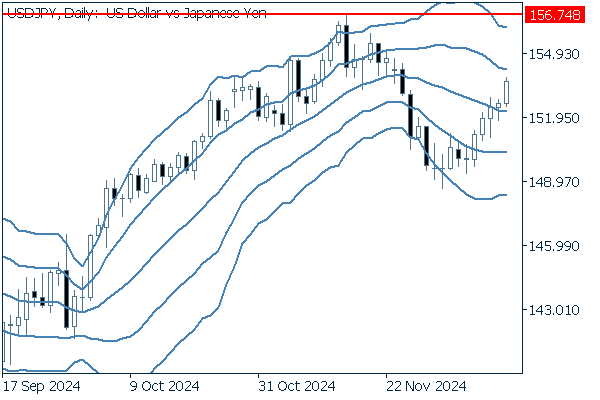

Six consecutive positive candlesticks appeared on the daily chart. The pair has broken above the middle line and is approaching +1σ. If the uptrend continues and the pair breaks above the 154 yen level, the recent high of 156.74 yen will turn into a fresh target.
We continue with an analysis of the USDJPY weekly chart.
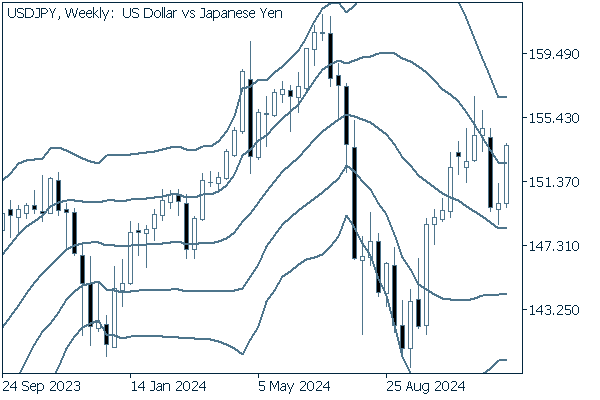

The pair has almost offset the plunge of the week of November 25th and broke well above +1σ last week. The uptrend is expected to continue.
EURUSD
As expected, the ECB Governing Council decided to cut interest rates.
With selling pressure on the euro mounting due to political turmoil in Germany and France, as well as President-elect Donald Trump's tariff policies, the market will likely wait and see how the dollar behaves before and after the FOMC Meeting on December 18th.
Next is an analysis of the EURUSD daily chart.
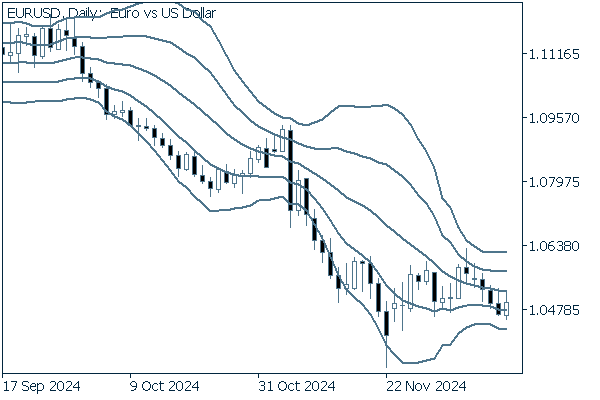

The pair has fallen after crossing above +1σ of the Bollinger Band. Also, the declining middle line is about to flatten out. On the daily chart, the pair lacks a clear trend.
We continue with an analysis of the EURUSD weekly chart.
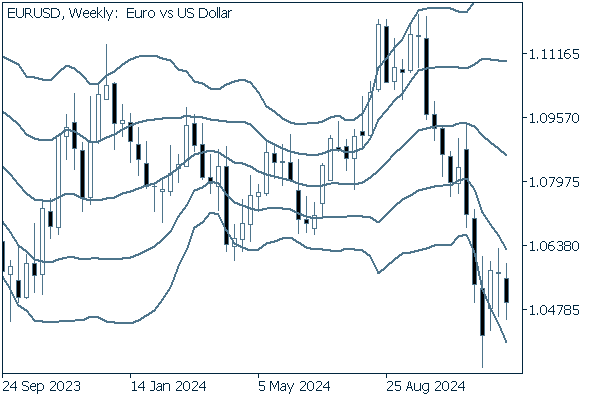

For the past three weeks, the pair has fluctuated between -1σ and -2σ. The middle line has also remained on a downward trend, which will likely continue.
GBPUSD
The U.K.'s monthly GDP has shrunk for the second month in a row, adding to the sense of uncertainty about the future.
The BOE is expected to leave interest rates on hold when it announces the minutes of the Monetary Policy Committee meeting on December 19th. As with the EURUSD, the GBPUSD will likely continue to be affected by the dollar's behavior.
Now, we analyze the daily GBPUSD chart.
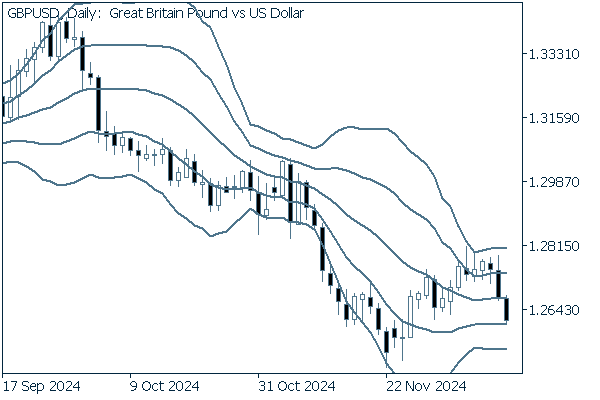

After fluctuating between +1σ and +2σ, the pair dropped below the middle line last Thursday and touched -1σ on Friday. Also, the middle line is about to flatten out. On the daily chart, the pair lacks a clear trend.
We continue with an analysis of the GBPUSD weekly chart.
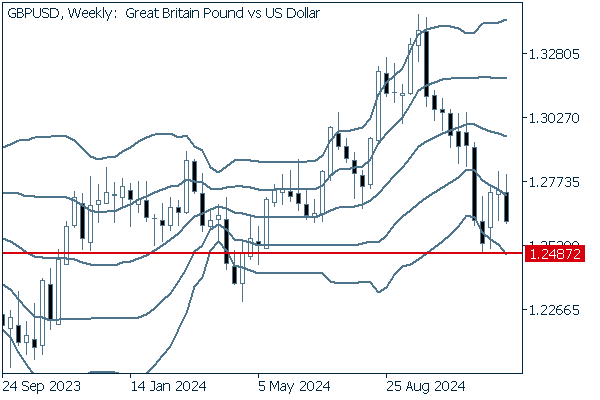

On the weekly chart, the pair had been rallying after breaking below -2σ. However, it failed to break above -1σ last week, and a bearish candlestick appeared. If it tries to move up toward the middle line, the pair will enter a range-bound market. However, if it breaks below 1.2487, the low of November 22nd, the downtrend may continue.
Was this article helpful?
0 out of 0 people found this article helpful.
Thank you for your feedback.
FXON uses cookies to enhance the functionality of the website and your experience on it. This website may also use cookies from third parties (advertisers, log analyzers, etc.) for the purpose of tracking your activities. Cookie Policy
